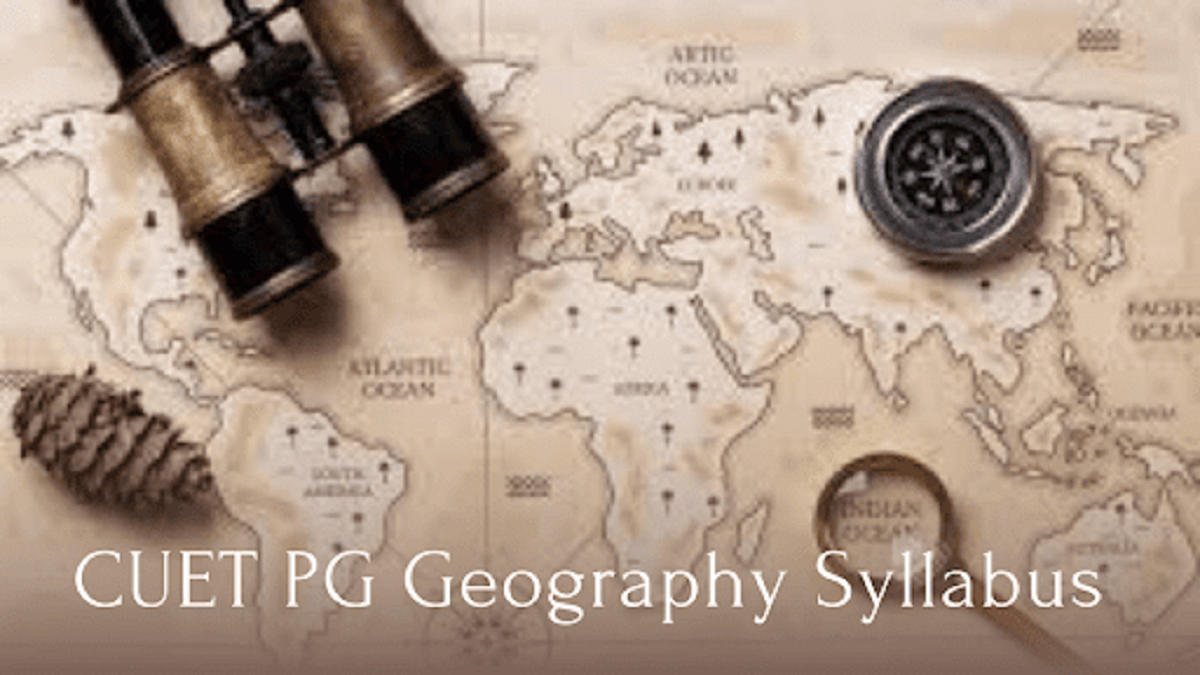Table of Contents
Knowing and getting familiar with the CUET PG Geography syllabus 2025 will not only help you become aware of the subject but also guide you in preparing your roadmap. The National Testing Agency has uploaded the fresh and revised CUET PG MA Geography Syllabus 2025 PDF on its portal.
Students who are going to appear for the Upcoming postgraduate entrance exam should carefully review the updated CUET MA Geography Syllabus 2025 which is discussed on this page in detail.
CUET PG Geography Syllabus 2025
The CUET PG Geography Question Paper 2025 will consist of 75 multiple-choice questions (MCQs) based on the chapters and Topics covered in the syllabus. These questions are mandatory and will be available in both English and Hindi.
Candidates who want to pursue postgraduate courses in geography should carefully review the whole syllabus. Studying according to the CUET PG Geography Syllabus 2025 would help them prepare properly and achieve good results.
CUET PG MA Geography Syllabus Complete Analysis
In the attached video, our in-house experienced faculty has shared a complete analysis of the Geography Syllabus for the CUET PG 2025 Exam. Please refer to the video and clear all your doubts here.
CUET PG MA Geography Exam Pattern
To pass the forthcoming exam, aspirants must first understand the CUET PG Exam Pattern and syllabus. It is critical to review the curriculum ahead of time to ensure optimal preparation and performance. The table below gives an outline of the CUET PG Geography Exam 2025.
| Particulars | Details |
|
Exam Conducting Body
|
National Testing Agency (NTA) |
|
Mode of Examination
|
Computer-Based Test (CBT) |
|
Medium/Language
|
English and Hindi |
|
Duration of Examination
|
90 Minutes |
| Frequency | Once a year |
|
Types of Questions
|
Multiple Choice Questions (MCQs) |
|
Total Number of Questions
|
75 questions asked form Domain-Specific Knowledge |
| Total Marks | 300 |
|
Marking Scheme
|
|
CUET PG Geography Syllabus in Detail
The syllabus of the CUET PG Geography is divided into three parts namely physical geography, human geography, and geographical techniques. These sections are further divided into several Sections. Let’s take a quick tour of the CUET PG MA Geography Syllabus sections-wise below.
CUET MA Physical Geography Syllabus
PART A: PHYSICAL GEOGRAPHY
Section I: Geomorphology
- Solar system and the Earth – Origin of the earth: important theories – Earth’s interior – Geological time scale Earth’s Materials and minerals – Rocks classification and characteristics – Earth surface configuration – Order of landforms – Wegner’s theory – Plate tectonics.
- Endogenic processes: Folds, Fault, Dome and their resultant landforms – Earthquakes and Volcanic activities: causes, resultant landforms and world distribution.
- Exogenic processes: Weathering, Mass wasting and resultant landforms – Formation of regolith and soil Geomorphic agents and processes: Fluvial, Glacial, Coastal, Arid and Karst landforms – Geomorphic hazards and their effects.
Section II: Climatology
- Elements of weather and climate – Composition and Structure of the Atmosphere – Head budget
- Atmospheric pressure: Vertical and horizontal distribution – Winds and their causes of circulation – Types of planetary, Periodic and local winds – Temperature: factors and distribution – Temperature inversion.
- Atmosphere moisture: Humidity, evaporation and condensation – Hydrological cycle – Types, regional and seasonal distribution – Monsoon.
- Air masses and Fronts- Atmospheric disturbances: Tropical and Temperate cyclones- Anti- cyclones – El Nino-Southern Oscillation (ENSO) – Recent climatic variability phenomenon.
- Climatic classification – Basis of Koppel’s and Thorn Thwaite’s classification – Role of climate in Human life – Atmospheric pollution and global warming: general causes and consequences.
Section III: Oceanography
- Surface configuration of the ocean floor – Hypsographic curve: continental self, continental slope, abyssal plain, trenches and deeps – Relief of Atlantic, Pacific, and Indian Oceans.
- Distribution of temperature and salinity of oceans and seas – Circulation of oceanic waters, waves and currents – Currents of Atlantic, Pacific and Indian oceans – Tides: causes, types and theories.
- Marine deposits – Coral reefs: types and their formation – Costal environment – Ocean as store house of resources for the future.
Section IV: Biogeography
- Biosphere: Meaning and concept – Components of ecosystem and ecology-Biomes: World major biomes and their characteristics
- Functions: Trophic levels, energy flows, cycles (geo-chemical, carbon, nitrogen and oxygen), food chain, food web and ecological pyramid
- Human interaction and impacts – Environmental ethics – Environmental hazards and disasters (global warming, urban heat island, atmospheric pollution, water pollution, land degradation). Environmental policies – Environmental impact assessment.
Section V: Physical Geography of India
- Land of diversities – Geological structure – Physical features and divisions- Drainage pattern – Soil types and distribution – Natural vegetation
- Climate: Seasons – Monsoon (origin, regional and seasonal variations) – Distribution of temperature and rainfall- Local winds
- Mineral and power resources: Major types and their potential, distribution and production – Sources of non-conventional energy.
CUET PG Human Geography Syllabus
PART B: HUMAN GEOGRAPHY
Section V Geographic Thought
- Nature and scope of geography – A brief historical overview of geography as a discipline – Branches of geography: general characteristics and inter-relationships.
- Contributions of Greek, Roman, Arab, Chinese and Indian Scholars – Contributors for the development of modern geography- Recent Trends in Geography.
- Dualisms in geographic studies (physical vs. human, regional vs. systematic, qualitative vs. quantitative, ideographic vs. nomothetic) – Paradigm shift – Perspectives in geography (positivism, behaviouralism, humanism, structuralism, feminism and postmodernism).
- Division of mankind – Racial groups and culture: systems, characteristics and distribution – Human Adaptation to the environment – Adaptation in modern society – Globalization and cultural change – Language, communication and belief.
- Distribution and density of population: Factors, growth and distribution- Population composition -Population theories – Health and wellbeing
- Migration: Internal and international – Settlements: rural and urban – Urbanization process – Patterns and world distribution – Population policies
Section VIII: Geography of Resources
- Nature and components of resources – Resources and environment interface – Classification of resources:
renewable and non-renewable, biotic and abiotic resources. - Water, forests and soil resources: Types, distribution, economic and environmental significance – problems of deforestation, soil erosion and water pollution.
- Exploitation of natural resources – Impact of Human activities: deforestation, mining, agriculture and industrialization on environment- Population pressure and resources utilization – Population explosion and food security
- Environmental hazards: pollution and its related problems -Emerging environmental problems – Global warming – Environmental conservation, preservation, and sustainable resource use.
Section IX: Economic Geography
- Sectors of economic activity: Primary, Secondary and Tertiary – Favourable geographical conditions for different economic activities.
- Agriculture: Primary crops (wheat, rice and maize), commercial crops (cotton, sugarcane, tea, coffee, rubber) distribution and production – Livestock and Fisheries-Important fishing grounds.
- Mining economy: Factors governing the exploitation of minerals – World reserves and production of Iron ore, Manganese, Bauxite and Copper.
- Fuel and power resources of the world – Distribution and production of coal, petroleum, hydroelectric power, atomic energy and non-conventional sources of energy.
- Manufacturing industries: Factors affecting location – growth and distribution of major industries – World production and distribution.
- Nature and trends in the International trade – World trade of wheat, cotton, tea, coffee, petroleum, gold, silver, gems and jewelry.
Transport: Relative significance of different means of transport – Factors affecting land, water and air transport – World oceanic routes – Important inland waterways and important canals – Impact of globalization on world economy.
Section X: Human Geography of India
- Cultural landscape: Population growth, distribution and density – Population composition – Settlements and Urbanization
- Agriculture: Major crops, impact of green revolution, Regionalization of Indian agriculture
- Industrial development – Location and distribution of iron and steel, cement, cotton textile and sugar industry – Industrial Regions and their characteristics – Industrial Policies in India
- Transport Networks (railways, roadways, waterways, airways and pipelines) – International Internal and External Trade (trend, composition and directions)
- Regional development planning in India – Globalization and its impact on Indian Economy- Changing nature of Indian economy – Socio-economic development – Impact of development on environment and natural resources.
CUET PG Geographical techniques Syllabus
PART-C GEOGRAPHICAL TECHNIQUES
Section XI: Cartography
- Elements of Map Science – Concepts of scale and map – Types of maps and scales – Construction of graphic/linear scales –
- Enlargement and reduction of maps: methods and procedures – Map compilation and generalization.
- General principles and classification of projections: construction, properties, limitations and uses of Zenithal, Conical and Cylindrical projections.
- Methods of showing relief- (hachure, shading, and contours) – Contour interpolation – Profiles: drawing of profiles and their relevance in landforms mapping and analysis – Identification of
different rocks-SOI Toposheets – Interpretation of physical and cultural topographic sheets. - Methods and instruments for collection of weather data – Construction of climograph and hythergraph, isotherm, isobars and isohyets – Preparation of weather maps-Symbols used in
weather maps – Interpretation of Indian daily weather maps.
Mapping techniques of population, social, economic and cultural data – dot, isopleth, and choropleth methods.
Section XII: Surveying Techniques
- Basic principles of surveying – Types of surveying – Surveying instruments – Basic principles of field work – Techniques in physical and socio-economic field surveys- Data collection methods.
- Chain and tape survey – Prismatic compass survey – Plane Table survey- Levelling techniques – Electronic surveying instruments (Theodolite and electronic devices)
Section XIII: Statistical Techniques
- Statistical Methods: Frequency distribution and histograms – Measures of central tendency and dispersion- Diagrammatic representation of geographical and statistical data.
- Sampling Techniques – Tests of significance – Probability distributions: normal, binominal and Poisson parametric and non-parametric tests-Correlation and regression.
Section XIV: Remote Sensing and GIS
- Remote sensing principles – Types of remote sensing – Aerial photography-Satellite images – Application of Remote Sensing Techniques.
- Components and function of GIS – Spatial and non-spatial data – Vector and raster format – GIS analysis – Application of GIS.
- Basic principles of Global Navigation Satellite System- Segments and applications.
CUET PG 2025 MA Geography Syllabus PDF Download
The CUET PG 2025 MA Geography Syllabus (HUQP08) in PDF format is now available on the NTA’s official website. The CUET PG Geography Syllabus PDF can be downloaded from the official website or through the provided download link provided below
CUET PG Geography Syllabus PDF
CUET PG Geography Exam Eligibility Criteria
Candidates interested in understanding the eligibility criteria for the CUET PG MA Geography 2025 can refer below to find out the requirements for the CUET PG Geography program. It is important to note that the eligibility requirements vary slightly from university to university, so check on their individual websites too.
Age Limit: The officials have not defined any age restrictions for the Geography program.
Academic Credentials Required
Delhi University (DU): Bachelor’s Degree from an accredited University or Master’s Degree from an accredited University with Geography as a subject, Or
Banaras Hindu University (BHU): A Bachelor’s degree in any field following the 10+2+3 educational system with a minimum of 45% marks.



 [Live Update] CUET PG Result 2025 @exams...
[Live Update] CUET PG Result 2025 @exams...
 CUET PG Cut Off 2025, Expected Course wi...
CUET PG Cut Off 2025, Expected Course wi...
 CUET PG Economics Previous Year Question...
CUET PG Economics Previous Year Question...




